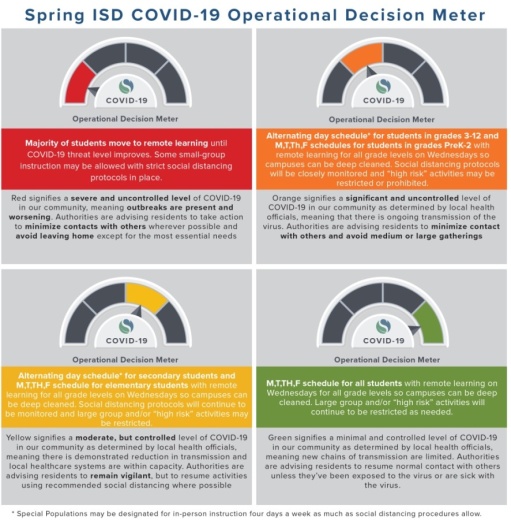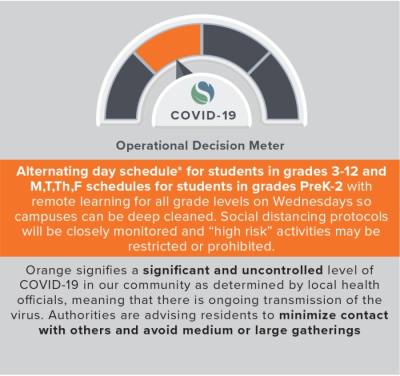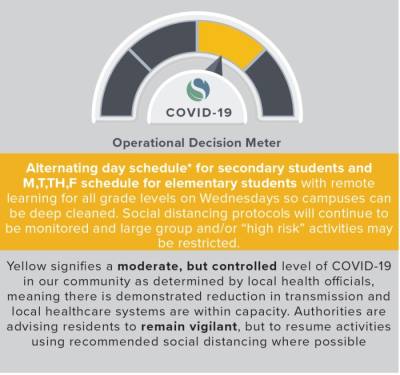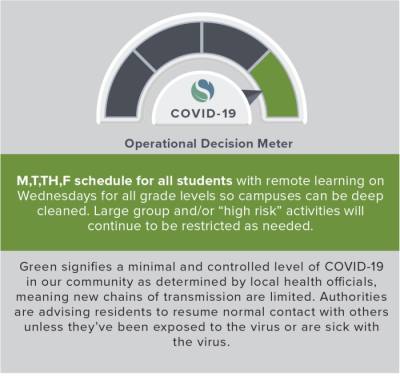As previously reported by Community Impact Newspaper, SISD formed 11 scenario-based planning teams with more than 100 members in late May. The teams spent the month of June tackling challenges, including class configurations, child nutrition, instructional technology and transportation, among others, and finding solutions that are flexible enough to adjust to a range of COVID-19 scenarios that may occur in the 2020-21 school year.
These solutions came together to form five micro plans surrounding various topics—including school schedules, class configurations, student learning, staffing and professional development, student and family support and facilities—that can meet the needs of the following scenarios:
- Scenario 1: Schools open with minimum social distancing;
- Scenario 2: Schools open with significant need for social distancing; or
- Scenario 3: Schools do not open, and remote learning continues.
According to Tiffany Dunne-Oldfield, SISD chief of innovation and communications, both options will allow students to participate in co-curricular activities, will offer a full suite of district student and family supports, will include standards-based curriculum and project-based learning experiences and will offer synchronous, or real-time, and asynchronous, or self-paced, learning.
While the Empowered Learning At-Home Model will not be affected by COVID-19, the district has developed an Operational Decision Meter—based on Harris County's COVID-19 Threat Level system—to guide district officials in adjusting the Safety-First Hybrid Model to fit the three scenarios.
"This is aligned with our local authorities, but it's also unique to Spring [ISD]," Dunne-Oldfield said. "We want to be clear that ... maybe Harris County is in the yellow or orange [threat level], but if we had an outbreak of COVID-19 in the district or in a particular ZIP code in the district or a particular area of the district, this is designed for us to use to have conversations with our families and communicate how we're making decisions, whether that's pulling back on in-person [learning] and going more remote for safety purposes or vice versa."
The Operational Decision Meter is broken down into the four following levels.
- Green (Scenario 1): Students attend in-person classes Mon.-Tue. and Thu.-Fri with remote learning on Wednesdays for all grade levels so campuses can be deep cleaned. Large group and/or high-risk activities will continue to be restricted as needed.
- Classroom occupancy is reduced by 25%.
- Bus occupancy is reduced by 25%, and two students are allowed per seat, with a maximum of 51 students per bus.
- Yellow (Scenario 2): Secondary students attend in-person classes on an alternating day schedule, and elementary students attend in-person classes Mon.-Tue. and Thu.-Fri. with remote learning on Wednesdays for all grade levels so campuses can be deep cleaned. Social distancing protocols will continue to be monitored, and large group and/or high-risk activities may be restricted.
- Classroom occupancy is reduced by 50%.
- Bus occupancy is reduced by 50%, and one student is allowed per seat, with a maximum of 26 students per bus.
- Orange (Scenario 2): Students in grades 3-12 attend in-person classes on an alternating date schedule and students in grades pre-k-2 attend in-person classes Mon.-Tue. and Thu.-Fri with remote learning on Wednesdays for all grade levels so campuses can be deep cleaned. Social distancing protocols will be closely monitored, and high-risk activities may be restricted or prohibited.
- Classroom occupancy is reduced by 50%
- Bus occupancy is reduced by 50%, and one student is allowed per seat, with a maximum of 26 students per bus.
- Red (Scenario 3): The majority of students move to remote learning until COVID-19 threat level improves. Some small-group instruction may be allowed with strict social distancing protocols in place.
- Classroom occupancy is reduced by 75%.
- Bus occupancy is reduced by 50-70%, and one student is allowed per row, with a maximum of 13 students per bus.
Additionally, while middle schools would remain on a seven-period schedule, high schools would switch from an eight-period schedule to an alternating block schedule. Special population students, which includes those who are in special education, the 504 plan or Response to intervention, or are English learners, Dyslexic, homeless or in foster care, will attend school in-person Mon.-Tue. and Thu.-Fri.
On the transportation side, routes for co-curricular activities will be provided to in-person and virtual students, buses will be thoroughly sanitized after each route, masks will be required, hand sanitizer will be provided, seats will be clearly marked to indicate social distancing requirements and bus windows will remain open to allow ventilation, weather permitting.
The district will continue to work to provide one device for every student in grades 3-12 to assist with remote learning and will also begin distributing internet hot spots to families in need.
On the staffing side, teachers who are at higher risk for COVID-19 infection will be given first consideration for remote teaching assignments and professional development will emphasize training in Schoology, the district's remote learning software, among other tools.
District officials also said they would be emphasizing the district's help desk by offering assistance both digitally and non-digitally in the district's three main languages: English, Spanish and Vietnamese.
According to Director of Child Nutrition Shelly Copeland, the United States Department of Agriculture has extended several waivers through June 2021, which will allow the district to continue serving students through a variety of options, such as curbside meal service, as the district has done since mid-March. The waivers will also allow the district to adjust meal times beyond the normal 10 a.m.-2 p.m. time period as may be needed for social distancing purposes.
"Both of these waivers, as well as others, will increase our flexibility with meal service this next year," Copeland said. "We do plan to offer meals Mon.-Fri., and the schedule for school meals, especially for lunch, can look different at every campus. We will be working with campus administrators to determine the needs of the campus—what it will look like for them and work best for them—and looking at social distancing by campus and how it will affect them and their schedules."
Copeland added that each campus will likely utilize a variety of serving methods, including meals served in the cafeteria, grab-and-go meals that can be taken to the classroom, meals delivered to the classroom and curbside meals for students who choose the Empowered Learning At-Home Model.
Finally, from a facilities standpoint, the district will install plexiglass screens at high-touch points, such as cafeteria cashiers and reception desks; provide bottle filling stations where possible if drinking fountains are shut down; limit campus visitors; review common areas to ensure a safe environment that complies with Centers for Disease Control guidelines; and enhance sanitation protocols.









